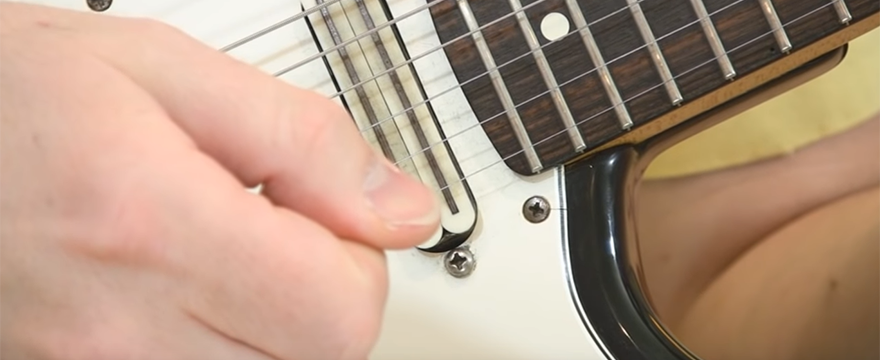Learn how to achieve better accuracy and coordination when it comes to picking with a guitar pick (plectrum). This lesson breaks down a series of drills that will help improve your skill when it comes to the use of traditional “plectrum” picking technique…
Q: I have a question that got me struggling for days… I didn’t find a lot of information about flat picking online. Is there a good or correct way to pick when playing single notes? My small finger and my middle-finger are always resting on the guitar… Is this a bad habit?
I’ve seen a lot of players have their hand resting on the bridge or at least near the bridge… Thanks in Advance!
~ Julien1345
A: There are several important points to keep in mind with regard to picking technique. In this lesson I will be covering this topic in two parts.
PART 1: Picking-hand Technique Development
(a). In developing the picking-hand start with how you are holding the pick. The basic way for holding the pick is to have it between your thumb and index finger. The index finger should be curled into the palm of the hand with the thumb nail pointing towards the guitars head-stock.
(b). Take a moment to notice exactly where the best place on your guitar is to perform the picking… watch carefully that you choose a good open area (without any pick-up pole pieces that could get in the way of your pick swing).
(c). Your wrist is the key to effective picking, how and where you hold it makes all the difference. It should float smoothly above the bridge and never be nailed /sitting upon the bridge in
any one location.
(d). There should never be any tension in the hand, wrist, or arm. Tension can promote stress on the muscles which can lead to injury. Tension is also one of the main causes of poor performance.
(e). When picking a note, angle your pick slightly downward. This will work to produce less friction since less surface area of the pick is covering the strings. This idea will also allow you to use a heavier gauge of guitar pick (better for dynamics), and in the end play notes faster with more volume and sustain.
(f). During the picking strokes, have your pick remain as close to the strings as possible. The picking strokes you make must be small in order to gradually increase your picking speed. Too much motion through your picking stroke will slow you down. The concept that we are working towards is one of minimal motion of pick and hand swing while playing notes.
PART 2: Awareness of Pick to String Location
One of the concepts that we want to avoid is picking from one firmly anchored point, (or in other words, a point where we are resting the hand on the guitar in some manner).
What we are after instead is freedom of movement and anchoring the hand into some permanent location does not allow for this.
It (anchoring), can be a tough thing to break if you have allowed it to form as a habit in your regular guitar playing. Many players tend to do anchoring out of instinct.
More than likely due to a instinctual need to know exactly where the tip of the pick is at all times. However, anchoring is very limiting since when doing it, the player has lost the freedom of movement necessary for speed and accuracy.
A great way to break out of this anchoring habit is to view your guitar’s six strings as two groups of three. Three bass strings and three treble.
If you are playing in the bass set, (strings 6, 5 and 4), then lightly brush your small fingers knuckle on the treble strings to maintain accuracy of movement and gain a firm sense of awareness of the tip of your pick (tracking notes) on those bass strings.
Moving to the treble strings, (strings 3, 2 and 1), work toward developing the ability of lightly brushing the heel of the palm of your hand on the low bass strings to gain a solid sense of where the pick is tracking notes to perform phrases with greater ease on the treble group of strings.
